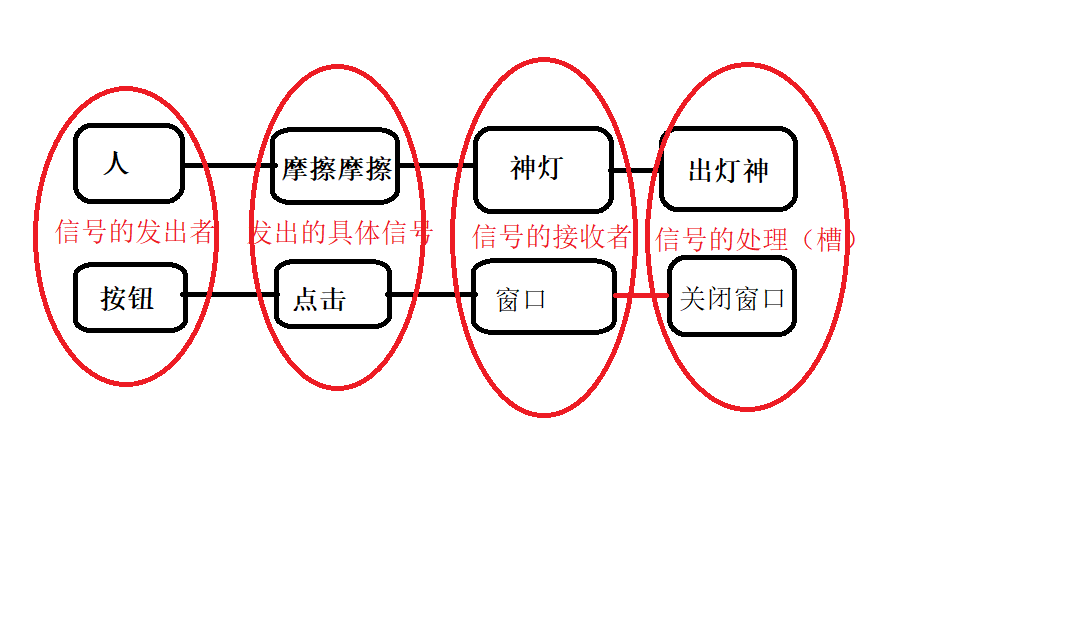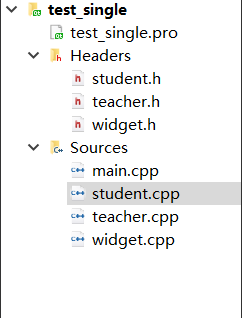信号和槽作为QT的最大特点,因为有了信号与槽的编程机制,在 Qt 中处理界面各个组件的交互操作时变得更加直观和简单。
举例来说明 信号和槽(传智播客经典举例)

伪代码说明
connect(信号的发送者,发送的具体信号,信号的接收者,信号的处理);
信号和槽的优点: 松散耦合,信号的发送端 和 接收端 本身没有关联,而是通过connect函数连接,将两端耦合在一起。
代码示例
1 #include "widget.h" 2 #include <QPushButton> //按钮控件的头文件 3 Widget::Widget(QWidget *parent) 4 : QWidget(parent) 5 { 6 //创建一个按钮 7 QPushButton * btn2=new QPushButton("点击我关闭",this); 8 //需求 点击按钮 关闭窗口 9 //参数1 信号发送者 参数2 具体的信号 参数3 信号的接收者 参数4 槽 10 connect(btn2,&QPushButton::clicked,this,&Widget::close); 11 } 12 13 Widget::~Widget() 14 { 15 }
自定义信号和槽
举例:铃声响了,老师发出下课信号,学生接收信号做出离开教室的反应
在工程下新建两个类 : 老师类 / 学生类

在teacher.h里自定义信号
1 #ifndef TEACHER_H 2 #define TEACHER_H 3 4 #include <QObject> 5 6 class teacher : public QObject 7 { 8 Q_OBJECT 9 public: 10 explicit teacher(QObject *parent = nullptr); 11 12 signals: 13 //自定义信号 写到 signals下 14 //返回值是void 只需要声明,不需要实现 15 //可以有参数,可以重载 16 void classover(); 17 }; 18 19 #endif // TEACHER_H
在student.h里定义信号处理函数
1 #ifndef STUDENT_H 2 #define STUDENT_H 3 4 #include <QObject> 5 6 class student : public QObject 7 { 8 Q_OBJECT 9 public: 10 explicit student(QObject *parent = nullptr); 11 12 signals: 13 14 public slots: 15 //早期QT版本 必须写到public slots下面,高级版本可以写到public或者全局下 16 //返回值是void 需要声明,也需要实现 17 //可以有参数,可以发送重载 18 void leaveclass(); 19 20 }; 21 22 #endif // STUDENT_H
在student.cpp里实现 离开教室反应 的功能
1 #include "student.h" 2 #include <QDebug> 3 student::student(QObject *parent) : QObject(parent) 4 { 5 6 } 7 8 void student::leaveclass(){ 9 qDebug()<<"离开教室咯"; 10 }
在widget.h中声明 老师 对象 以及 学生对象 ,并且声明 响铃函数
1 #define WIDGET_H 2 3 #include <QWidget> 4 #include "teacher.h" 5 #include "student.h" 6 class Widget : public QWidget 7 { 8 Q_OBJECT 9 10 public: 11 Widget(QWidget *parent = nullptr); 12 ~Widget(); 13 private: 14 teacher *zt; 15 student *st; 16 void classringing(); 17 }; 18 #endif // WIDGET_H
在widget.cpp中创建 老师对象和学生对象 ,并通过connect连接,最后调用响铃函数 使得老师发出下课信号
1 #include "widget.h" 2 3 //Teacher类 4 //Student类 5 //铃声响了,老师发出下课的信号,学生接收信号做出离开教室的反应 6 7 Widget::Widget(QWidget *parent) 8 : QWidget(parent) 9 { 10 //创建 老师对象 11 this->zt=new teacher(this); 12 //创建 学生对象 13 this->st=new student(this); 14 //老师说下课了,学生齐刷刷离开教室 15 connect(zt,&teacher::classover,st,&student::leaveclass); 16 //调用响铃函数 17 classringing() 18 } 19 20 void Widget::classringing() 21 { 22 emit zt->classover(); 23 } 24 25 Widget::~Widget() 26 { 27 }
成果展示
